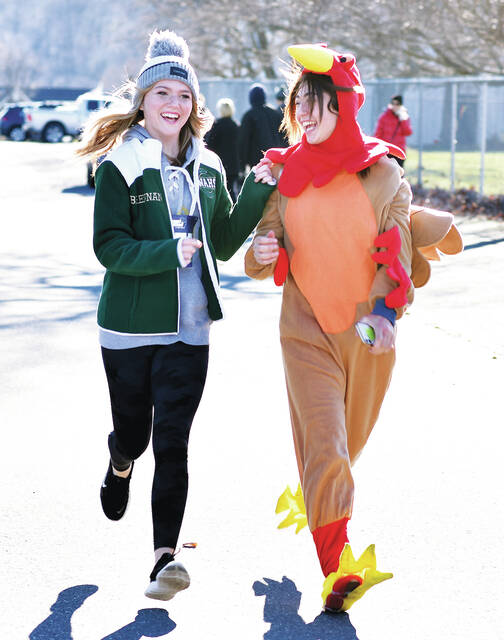
Francine Graham, right, dressed as a turkey for a Turkey Trot along side friend Brenna Slocum. (Photo by Tony Callaio)
ROCKINGHAM — Although Black Friday and Cyber Monday have slowly morphed into a ‘Black November’ with sales commencing earlier, the origins of the cyber event date back to the Y2K days.
After noticing an increasing number of consumers were shopping online after Thanksgiving, the NRF’s Shop.org established Cyber Monday in 2005. While some experts believe that early 2000s buyers waited until Monday to make purchases at work, where they had access to faster internet speeds — an advantage over slower home connections at the time — other experts credit its popularity to the ease of avoiding huge lines.
According to Adobe Analytics, Cyber Monday last year surpassed the previous record for online spending at $12.4 billion.
Cyber Monday impacted businesses all across the world. With 28 countries participating, it has transformed into a worldwide marketing phenomenon since its debut in the United States.
According to Finances Online, the UK, Germany, Spain, Italy, the Netherlands, Sweden, and Denmark are some of the countries with highest awareness and participation in Cyber Monday sales.
Another tradition that has grown with time is the Turkey Trot.
The now-infamous fun run, known as the Turkey Trot, dates back to 1896 in Buffalo, New York. The local YMCA hosted an 8K cross-country race with just six participants. They ran an impressive five miles along the dirt roads of downtown Buffalo. Only four runners made it to the finish line — but who’s counting? Henry A. Allison was crowned first place with a time of 31 minutes and 12 seconds.
By the early 1900s, the race moved to pavement, though women weren’t allowed to participate until 1972. Over time, the Turkey Trot phenomenon spread across the East Coast, reaching cities such as New Orleans in 1907, Berwick, Pennsylvania, in 1908, Cincinnati in 1909, and Troy, New York, in 1916.
As running gained popularity, so did the iconic Turkey Trot. The Dallas YMCA Turkey Trot, which started with 107 runners in 1967, now draws about 20,000 participants each year. The event has become a family-friendly tradition, with runners dressing up as turkeys, pilgrims and other autumn-themed characters.
Reach Ana Corral at acorral@cmpapers.com

